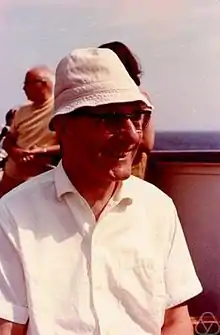Hans Maass
Hans Maass (German: Hans Maaß; June 17, 1911, Hamburg – April 15, 1992) was a German mathematician who introduced Maass wave forms (Maass 1949) and Koecher–Maass series (Maass 1950) and Maass–Selberg relations and who proved most of the Saito–Kurokawa conjecture. Maass was a student of Erich Hecke.

Hans Maass
Publications
- Maass, Hans (1949), "Über eine neue Art von nichtanalytischen automorphen Funktionen und die Bestimmung Dirichletscher Reihen durch Funktionalgleichungen", Mathematische Annalen, 121: 141–183, doi:10.1007/BF01329622, ISSN 0025-5831, MR 0031519
- Maass, H.(1949) "Automorphe Funktionen von mehreren Veranderlichen und Dirichletsche Reihen", Abh. Math. Sem. U. Hamburg 16:72–100.
- Maass, Hans (1950), "Modulformen zweiten Grades und Dirichletreihen", Mathematische Annalen, 122: 90–108, doi:10.1007/BF01342953, ISSN 0025-5831, MR 0037870
- Maass, Hans (1955), On Siegel's Modular Functions (PDF), Tata Institute of Fundamental Research Lectures on Mathematics, 3
- Maass, Hans (1964), Lal, Sunder (ed.), Lectures on modular functions of one complex variable (PDF), Tata Institute of Fundamental Research Lectures on Mathematics, 29, Bombay: Tata Institute of Fundamental Research, ISBN 978-3-540-12874-8, MR 0218305
- Maass, Hans (1971), Siegel's modular forms and Dirichlet series, Lecture Notes in Mathematics, 216, Berlin, New York: Springer-Verlag, doi:10.1007/BFb0058625, MR 0344198
References
- Busam, R.; Freitag, E. (1999), "Hans Maass(17. 6. 1911-15. 4. 1992)", Jahresbericht der Deutschen Mathematiker-Vereinigung, 101 (3): 135–150, ISSN 0012-0456, MR 1713154
This article is issued from Wikipedia. The text is licensed under Creative Commons - Attribution - Sharealike. Additional terms may apply for the media files.
